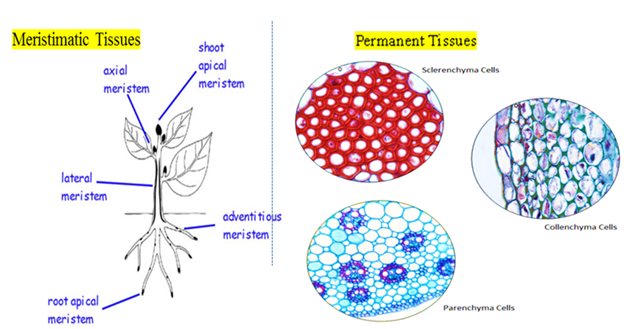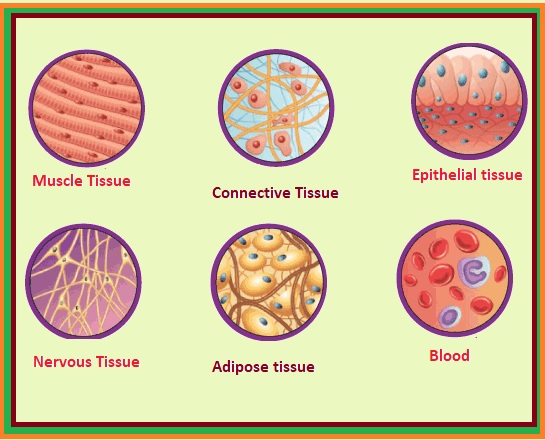CBSE Class 9 Science Chapter 6 Revision Notes
Chapter 6: Tissues Revision Notes
- Tissue is a collection of cells with a common origin, structure, and function. Histology is the study of tissues.
- A single cell in a unicellular creature (Amoeba) performs all fundamental activities, however, in multicellular organisms (Plants and Animals), there is a division of labour between Plant and Animal tissues.
PLANT TISSUES

- There are two types of plant tissues: meristems and permanent tissues.
Meristems
- Meristems are tissues that have the ability to divide cells. It may be discovered on the plant’s growing regions.
- The Apical meristems are found near the growing tip of the stem and roots, and they enhance the length of the stem and roots.
- Lateral meristems– located on the lateral side of the stem and root (cambium), they increase the girth.
- Intercalary meristems- found in the internodes or base of the leaves, these meristems lengthen the distance between the nodes.
Permanent Tissue
There are two types of permanent tissues: Simple permanent tissues and Complex permanent tissues.
a) Permanent simple tissues
Parenchyma
- Offers support to plants.
- They are loosely packed and have a lot of internal room.
- Chlorenchyma is parenchyma that contains chlorophyll and performs photosynthesis.
- Aerenchyma is a kind of parenchyma that has vast air gaps to provide buoyancy.
- Food and water are also stored in the parenchyma.
Collenchyma
- Tissue that provides mechanical support, is thickened at the corners, and has very little intercellular space.
- It enables simple bending of various plant components without breaking them.
Sclerenchyma
- Tissue thickens the plant, making it rigid and stiff, with no intercellular space owing to lignin. This tissue’s cells are dead and may be found in the husk of a coconut.
Guard cells and epidermal tissue
- The tissue contributes in gas exchange and protection.
- To protect the stomata, dicots have kidney-shaped guard cells, while monocots have dumbbell-shaped guard cells.
- The epidermal tissues of roots contribute in water and mineral absorption. Cutin forms a thick waxy covering on the epidermal tissues of desert plants, which makes them impermeable. The epidermal tissues comprise the tree’s Cork or Bark, which is many layers thick.
b) Permanent complex tissues
- Complex tissues are made up of several cell types. All of these cells work together to accomplish a shared goal. They are classified into the following categories:
- Tracheids, vessels, xylem parenchyma, and xylem fibres make up the xylem. The walls of the cells are thick.
- Xylem aids in the transport of water and minerals.
- Sieve tubes, companion cells, phloem parenchyma, and phloem fibres make up** phloem.**
- Phloem distributes food material from the roots to different sections of the plant.
ANIMAL TISSUES

- Animal Tissues are subdivided into Epithelial tissue, Connective tissue, Muscular Tissue and Nervous Tissue.
Epithelial Tissue
-
Epithelial tissue is a continuous sheet-like protective layer. Simple epithelium is made up of a single layer that is exceedingly thin, whereas stratified epithelium is made up of layers that are ordered in a pattern.
a) Squamous epithelium in the lining of the mouth and oesophagus
b) Squamous epithelium in the lining of the oesophagus
c) Squamous epithelium in the lining of kidney tubules and salivary glands, cuboidal epithelium. Intestinal columnar epithelium and respiratory tract lining columnar epithelium with cilia
d) Glandular epithelial cells in the Glands have a unique role as gland cells that secrete at the epithelial surface.
Connective Tissue
a) Blood
- Blood is a connective tissue that is fluid in nature. RBCs (Red Blood Cells), WBCs (White Blood Cells), and platelets make up blood plasma.
- Proteins, salts, and hormones are all found in blood plasma. Gases, digested food, hormones, and waste products are all transported by blood.
b) Bone
- Bone is a connective tissue made up of calcium and phosphorus that has a hard matrix.
- A bone is joined to another bone via ligaments, which are connective tissue.
- Muscle connects a bone to a tendon, which is another connective tissue.
c) Cartilage
- Cartilage is a connective tissue made up of a solid protein and sugar matrix.
- The nose, ear, trachea, and larynx are all typical places to find it.
d) Areolar Connective Tissue
- This type of connective tissue can be found between the skin and muscles, as well as surrounding blood vessels.
- It helps to restore tissues and supports interior organs.
e) Adipose Connective Tissue
- It is made up of fat globules and is used to store fat.
- It serves as an insulator.
Muscular Tissue
- They have contractile proteins that allow them to move about. There are three types:
- Striated muscles, also known as skeletal muscles or voluntary muscles, are cylindrical, unbranched, and multinucleated muscle fibres. They come in two colours: dark and bright.
- Unstriated muscles, often known as smooth muscles or involuntary muscles, are characterised by the absence of striations (dark and light bands). Iris of an eye, alimentary canal, and uterus are all common locations. They have a spindle form to them. Nature is involuntary.
- Cardiac Muscles are cylindrical, branching, and uni-nucleate muscles that are generally referred to as heart muscles. Nature is involuntary.
Nervous Tissue
- Nervous Tissue is a type of tissue that reacts to stimuli.
- Nervous tissue, or neurons, make up the brain, spinal cord, and nerves.
- Cell Body, Cytoplasm, Nucleus, Dendrite, Axon, and Nerve Endings make up a neuron.
- When we wish to respond to stimuli, we use neuron impulses to move our muscles.
